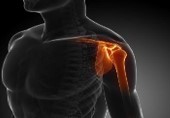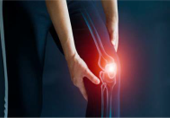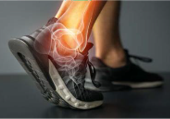The Injury Problem:


-
Over $600B is spent annually in the USA due to musculoskeletal (MSK) injuries.[i]
-
Athletes, sports teams, & corporations lose hundreds of millions of $ yearly from injury fallout.[ii]
-
Athletic injuries are mainly joint related and can end careers, with joint anatomy (ankles, knees, hips and shoulders) being the most prone to serious injury.[iii]
-
Many of these injuries are directly related to weakness of supporting muscles and structures surrounding the joints and lack of Balance-Strength™.[iv]
-
Improving Balance-Strength™ capability over time requires a progressive training system that continually increases challenge to the user as their capability increases[v], but no systems like this are available without being prohibitively expensive.
Balance-Strength™ Training Can Reduce Injuries:
-
Multiple clinical reports show the importance and success of a dynamic balance training program in preventing and reducing MSK injuries by stabilizing joints and improving balance and neuromuscular control, including proprioception.[vi] [vii]
-
Scientific studies demonstrate that effective injury prevention requires a high focus on joint stabilization, and dynamic balance training is an essential component in preventing injury by building dynamic stability and fine motor control at susceptible joints for improved muscular support, stability, and performance.[viii] [ix]
-
Improving balance and proprioception addresses performance challenges such as orientation in space, changes in direction, and the speed or height of the body’s center of mass during static and dynamic situations experienced constantly by athletes. Targeted proprioceptive training programs can improve balance, coordination, motor learning, and overall physical performance. [x] [xi] [xii]
-
Many studies demonstrate that the addition of dynamic balance training to resistance training programs also provides significant improvements in trunk strength, which is needed for improved ability to perform any type of physical activity involving core muscles.[xiii] [xiv] [xv]
-
In one study, not only did this type of training improve trunk extension (peak torque/body weight) by 23.6% and total work output by 20.1%, but it also improved knee proprioception by 44.7% from pre- to post-training, and persisted by 21.5% for 9 months post training. This study went on to state that this type of training provides not only prolonged improvements in joint proprioception and core strength, it may also result in reduced joint injuries over a protracted period.[xvi]
-
Improving neuromuscular control and the ability to balance also affects reaction times, and less than optimal reaction times can lead to MSK injuries. [xvii]
-
By placing the body in a multi-sensory environment (unstable yet controlled) the brain learns how to better manipulate the MSK system to produce movement with the right amount of force in the right location at the right time.[xviii]
-
If the structures of the brain, nerves, and muscles are never challenged, they will never be forced to adapt and improve (neuroplasticity, myoplasticity) in their functional capabilities. Without consistent and progressive challenges, these structures remain static, leading to potential declines in function and performance. [xix]
-
Improvements in neuro-muscular functional capabilities can translate to a reduction in MSK injuries.
ZeSa’s Dynamic Balance-Strength Training System Boosts Injury Prevention:
-
The ideal balance program is one that challenges both static and dynamic balance with a focus on coordination.[xx] The ZeSa system does this.
-
Progressive tools are necessary to increase muscle adaptation and control and prevent injury, and ALL muscle layers must be firing for strength and stability growth (known as Dynamic Stability).[xxi] The ZeSa system provides these tools and is fully progressive over a large capability range.
-
Dynamic Balance Training also facilitates body awareness with the benefit of “remembered” reactions to imbalance created in training situations. Balance awareness becomes an innate, automatic skill that can reduce the probability of injury.[xxii]
-
Use of the ZeSa® Dynamic Balance-Strength™ Training System leads to heightened athletic performance, resolving muscle imbalances, and reduction in injuries and associated costs.
-
ZeSa’s Dynamic Balance-Strength Training System™ trains the neuromuscular system and stabilizes and strengthens the entire MSK system, including ligaments and tendons that surround joints most prone to overuse and injury (i.e., ankles, knees, hips, and shoulders). This mitigates joint instability while simultaneously training major skeletal muscles and the associated stabilizing muscles.
-
ZeSa’s progressive system provides low to no impact training methods which reduce the incidence of training-induced injuries and is suitable for all ages, fitness and athletic levels at reasonable cost.
[i] https://injuryfacts.nsc.org/home-and-community/safety-topics/sports-and-recreational-injuries/
[ii] Romero-Morales C, López-López D, Almazán-Polo J, Mogedano-Cruz S, Sosa-Reina MD, García-Pérez-de-Sevilla G, Martín-Pérez S, González-de-la-Flor Á. Prevalence, diagnosis and management of musculoskeletal disorders in elite athletes: A mini-review. Dis Mon. 2024 Jan;70(1):101629. doi: 10.1016/j.disamonth.2023.101629. Epub 2023 Sep 15. PMID: 37716840.
[iii] Goes, R.A., Lopes, L.R., Cossich, V.R.A. et al. Musculoskeletal injuries in athletes from five modalities: a cross-sectional study. BMC Musculoskelet Disord 21, 122 (2020). https://doi.org/10.1186/s12891-020-3141-8
[iv] Lauersen JB, Bertelsen DM, Andersen LB. The effectiveness of exercise interventions to prevent sports injuries: a systematic review and meta-analysis of randomised controlled trials. Br J Sports Med. 2014 Jun;48(11):871-7. doi: 10.1136/bjsports-2013-092538. Epub 2013 Oct 7. PMID: 24100287.
[v] Wahl, Michael J; Behm, David G. Not All Instability Training Devices Enhance Muscle Activation in Highly Resistance-Trained Individuals. Journal of Strength and Conditioning Research 22(4):p 1360-1370, July 2008. | DOI: 10.1519/JSC.0b013e318175ca3c
[vi] Hertel J. Functional Anatomy, Pathomechanics, and Pathophysiology of Lateral Ankle Instability. J Athl Train. 2002 Dec;37(4):364-375. PMID: 12937557; PMCID: PMC164367.
[vii] Akbari A, Ghiasi F, Mir M, Hosseinifar M. The Effects of Balance Training on Static and Dynamic Postural Stability Indices After Acute ACL Reconstruction. Glob J Health Sci. 2015 Jul 31;8(4):68-81. doi: 10.5539/gjhs.v8n4p68. PMID: 26573034; PMCID: PMC4873586.
[viii] Cruz-Diaz D, Lomas-Vega R, Osuna-Pérez MC, Contreras FH, Martínez-Amat A. Effects of 6 Weeks of Balance Training on Chronic Ankle Instability in Athletes: A Randomized Controlled Trial. Int J Sports Med. 2015 Aug;36(9):754-60. doi: 10.1055/s-0034-1398645. Epub2015 May 13. PMID: 25969966.
[ix] Lee HG, An J, Lee BH. The Effect of Progressive Dynamic Balance Training on Physical Function, The Ability to Balance and Quality of Life Among Elderly Women Who Underwent a Total Knee Arthroplasty: A Double-Blind Randomized Control Trial. Int J Environ Res Public Health. 2021 Mar 3;18(5):2513. doi: 10.3390/ijerph18052513. PMID: 33802559; PMCID: PMC7967306.
[x] Yılmaz, O., Soylu, Y., Erkmen, N. et al. Effects of proprioceptive training on sports performance: a systematic review. BMC Sports Sci Med Rehabil 16, 149 (2024). https://doi.org/10.1186/s13102-024-00936-z
[xi] Yılmaz O, Soylu Y, Erkmen N, Kaplan T, Batalik L. Effects of proprioceptive training on sports performance: a systematic review. BMC Sports Sci Med Rehabil. 2024 Jul 4;16(1):149. doi: 10.1186/s13102-024-00936-z. PMID: 38965588; PMCID: PMC11225257.
[xii] Gidu DV, Badau D, Stoica M, Aron A, Focan G, Monea D, Stoica AM, Calota ND. The Effects of Proprioceptive Training on Balance, Strength, Agility and Dribbling in Adolescent Male Soccer Players. Int J Environ Res Public Health. 2022 Feb 11;19(4):2028. doi: 10.3390/ijerph19042028. PMID: 35206215; PMCID: PMC8871985.
[xiii] Barrio ED, Ramirez-Campillo R, Garcia de Alcaraz Serrano A, RaquelHernandez-García R. Effects of core training on dynamic balance stability: A systematic review and meta-analysis. J Sports Sci. 2022 Aug;40(16):1815-1823. doi: 10.1080/02640414.2022.2110203. Epub 2022 Aug 17. PMID: 35976032.
[xiv] Ferri-Caruana A, Prades-Insa B, Serra-AÑÓ P. Effects of pelvic and core strength training on biomechanical risk factors for anterior cruciate ligament injuries. J Sports Med Phys Fitness. 2020 Aug;60(8):1128-1136. doi: 10.23736/S0022-4707.20.10552-8. PMID: 32955839.
[xv] https://doaj.org/article/6c555ec587a3420e9560d628ab22d6c5
[xvi] Cuğ M, Ak E, Ozdemir RA, Korkusuz F, Behm DG. The effect of instability training on knee joint proprioception and core strength. J Sports Sci Med. 2012 Sep 1;11(3):468-74. PMID: 24149355; PMCID: PMC3737939.
[xvii] Zemková E, Zapletalová L. The Role of Neuromuscular Control of Postural and Core Stability in Functional Movement and Athlete Performance. Front Physiol. 2022 Feb 24;13:796097. doi: 10.3389/fphys.2022.796097. PMID: 35283763; PMCID: PMC8909639.
[xviii] NASM Essentials of Personal Fitness Training, 7th Edition, Chapter 7: Intro to Human Movement Science.
[xix] https://www.physio-pedia.com/Neuroplasticity
[xx]H ttps://www.americansportandfitness.com/blogs/fitness-blog/balance-in-motion-dynamic-vs-static-stability-exercises
[xxi] Okudaira, M., Hirono, T., Takeda, R. et al. Longitudinal development of muscle strength and relationship with motor unit activity and muscle morphological characteristics in youth athletes. Exp Brain Res 241, 1009–1019 (2023). https://doi.org/10.1007/s00221-023-06590-0
[xxii] https://www.collegesportsscholarships.com/balance-training-athletes
